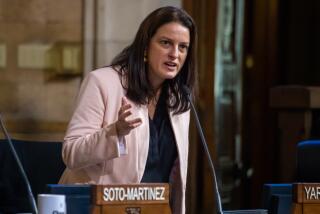More Federal Aid Sought for Cities at Risk of Attack
WASHINGTON — Terrorist surveillance reports recovered in a raid in Pakistan have provided the latest evidence that certain landmarks in the United States are of special interest to Al Qaeda.
Although these prime targets are in urban areas on the coasts, federal funds for protecting the U.S. against terrorist attacks are spread widely across the nation, with significant shares devoted to rural areas and small cities in the middle of the country.
Even the program designed specifically for security in metropolitan areas at risk was shared among 50 cities last year. New York -- where the new evidence shows Al Qaeda cased the New York Stock Exchange and several financial institutions -- has seen its share of $800 million in security funds shrink from $222 million in 2003 to $62 million this year, according to the Department of Homeland Security.
In the same period, said Paul Browne, deputy commissioner of the New York Police Department, money for police overtime dropped from $32 million to $7 million, although costs remained the same.
“The reality is,” Browne said, “the threat is much more concentrated than the federal allocations reflect.”
Efforts to redirect more money to the most vulnerable sites have been stymied by Congress’ traditional method of winning support for major spending initiatives: give every state and district a piece of the pie.
But the latest information from Pakistan and concerns of the Sept. 11 commission about priorities have provided new impetus for focusing on the cities known to be in the terrorists’ crosshairs.
“I don’t think Congress can afford to go home without passing a formula that mandates funding for first responders be done on a threat-based standard,” said Rep. John E. Sweeney (R-N.Y.)
Last month, the Sept. 11 commission called on Congress to “base federal funding for emergency preparedness solely on risks and vulnerabilities, putting New York City and Washington, D.C., at the top of the current list.”
“Such assistance should not remain a program for general revenue sharing or pork-barrel spending,” the commission said.
Just before its August recess, the House committees with jurisdiction over domestic security agreed -- after months of wrangling -- on a plan to apportion funds according to a new federal formula assessing vulnerability. Still, that bill ensured that each state would receive at least 0.025% of the money.
Democratic and Republican supporters contend the bill could be approved soon after Congress resumes work in September.
The Senate picture is less clear. A measure drafted by Sen. Susan Collins (R-Maine) was approved by the Senate Government Affairs Committee more than a year ago, but has languished since.
Sen. Hillary Rodham Clinton (D-N.Y.) said it was up to President Bush to ensure that cities such as New York, Washington and Los Angeles got more money. “There is no real pressure from the White House, so politics as usual takes over,” she said in an interview.
With its budget proposal for fiscal 2005, the Bush administration tried to redistribute domestic security funds by doubling to $1.4 billion the money in one program that weighed the threat level.
But the House, in its appropriations bill, rejected that. Its measure would still allocate most funds based on population. The Senate has not passed its bill.
Under the current system, 40% of the funds from the largest preparedness program for domestic security, which supplied $1.7 billion to states in 2004, are distributed equally among the states. The remainder is distributed based on population. For example, in 2004 Wyoming received $14 million, or $29 per capita; New York received $78 million, or $4 per capita; and California received $133 million, or less than $4 per capita, the Congressional Research Service said.
Some small counties have not known what to do with the money. Mason County, Wash., which is in a logging region, used $63,000 to buy a decontamination unit for dealing with hazardous materials. However, because the county had no hazmat team, the equipment was left sitting in a warehouse across the street from the sheriff’s office, an April report by the House Select Committee on Homeland Security found.
Although the Bush administration wants to shift some funds from that state grant program, it does not favor gutting it.
“We are supportive of the state grant program, because it enhances preparedness across the nation,” said Valerie Smith, a spokeswoman for the Homeland Security Department. “At the same time, we recognize the need to get more money to those urban areas with greater security needs.”
But critics say that many in Congress have treated the security funds as just another way to bring home federal money to their districts.
“Congress treating it as some way to get a new fire engine for the local fire company is rather obscene,” Sweeney said.
Meanwhile, cities such as New York and Washington are looking at extensive new defenses to protect their most vulnerable sites. In Washington, law enforcement officers are screening more traffic around the Capitol and Treasury buildings and considering more structural changes.
Eleanor Holmes Norton, a Democrat who serves as the District of Columbia’s nonvoting delegate to Congress, said the latest “orange alert has taken New York and the District of Columbia into the stratosphere” in security costs.
But it is not clear whether the latest terrorism threats will be enough to prompt Congress to redistribute funds.
“It runs contrary to the democratic spirit,” said John Lindsay, vice president of the Council on Foreign Relations. “which is to make sure we sent money to protect everybody.”
More to Read
Sign up for Essential California
The most important California stories and recommendations in your inbox every morning.
You may occasionally receive promotional content from the Los Angeles Times.










